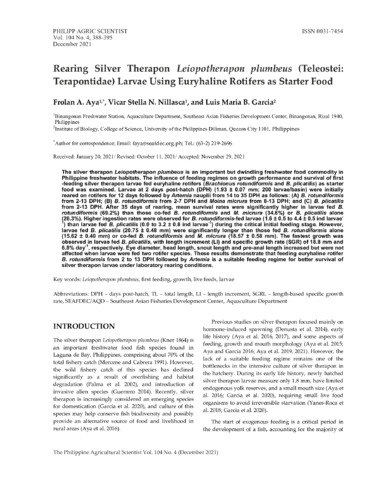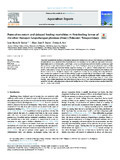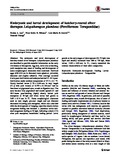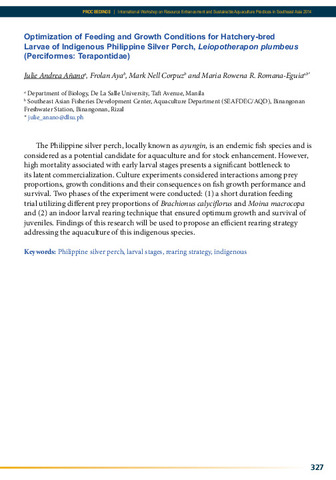Rearing silver therapon Leiopotherapon plumbeus (Teleostei: Terapontidae) larvae using euryhaline rotifers as starter food
Share
Abstract
The silver therapon Leiopotherapon plumbeus is an important but dwindling freshwater food commodity in Philippine freshwater habitats. The influence of feeding regimes on growth performance and survival of first-feeding silver therapon larvae fed euryhaline rotifers (Brachionus rotundiformis and B. plicatilis) as starter food was examined. Larvae at 2 days post-hatch (DPH) (1.93 ± 0.07 mm; 200 larvae/basin) were initially reared on rotifers for 12 days followed by Artemia nauplii from 14 to 35 DPH as follows: (A) B. rotundiformis from 2-13 DPH; (B) B. rotundiformis from 2-7 DPH and Moina micrura from 8-13 DPH; and (C) B. plicatilis from 2-13 DPH. After 35 days of rearing, mean survival rates were significantly higher in larvae fed B. rotundiformis (69.2%) than those co-fed B. rotundiformis and M. micrura (34.6%) or B. plicatilis alone (26.3%). Higher ingestion rates were observed for B. rotundiformis-fed larvae (1.6 ± 0.5 to 4.4 ± 0.5 ind larvae-1) than larvae fed B. plicatilis (0.0 to 3.2 ± 0.8 ind larvae-1) during the critical initial feeding stage. However, larvae fed B. plicatilis (20.75 ± 0.48 mm) were significantly longer than those fed B. rotundiformis alone (15.62 ± 0.40 mm) or co-fed B. rotundiformis and M. micrura (18.57 ± 0.58 mm). The fastest growth was observed in larvae fed B. plicatilis, with length increment (LI) and specific growth rate (SGR) of 18.8 mm and 6.8% day-1, respectively. Eye diameter, head length, snout length and pre-anal length increased but were not affected when larvae were fed two rotifer species. These results demonstrate that feeding euryhaline rotifer B. rotundiformis from 2 to 13 DPH followed by Artemia is a suitable feeding regime for better survival of silver therapon larvae under laboratory rearing conditions.
Suggested Citation
Aya, F., Nillasca, V. S. N., & Garcia, L. M. (2021). Rearing silver therapon Leiopotherapon plumbeus (Teleostei: Terapontidae) larvae using euryhaline rotifers as starter food. Philippine Agricultural Scientist , 104(4), 388-395. http://hdl.handle.net/10862/6284
Subject
Taxonomic term
Collections
- AQD Journal Articles [1249]
Related items
Showing items related by title, author, creator and subject.
-
Point-of-no-return and delayed feeding mortalities in first-feeding larvae of the silver therapon Leiopotherapon plumbeus (Kner) (Teleostei: Terapontidae)
Garcia, Luis Maria; Sayco, Mary Jane P.; Aya, Frolan (Elsevier, 2020-02)This study examined the incidence of mortalities among first-feeding post-yolk sac silver therapon Leiopotherapon plumbeus (Kner) larvae deprived of live food in the hatchery. Starting after their yolk was consumed at 40 ... -
Embryonic and larval development of hatchery-reared silver therapon Leiopotherapon plumbeus (Perciformes: Terapontidae)
Aya, Frolan; Nillasca, Vicar Stella N.; Garcia, Luis Maria; Takagi, Yasuaki (Springer Verlag, 2016)The embryonic and larval development of hatchery-reared silver therapon Leiopotherapon plumbeus are described to provide essential information on the early life history of this species. Egg size, larval size at hatching, ... -
Optimization of feeding and growth conditions for hatchery-bred larvae of indigenous Philippine silver perch, Leiopotherapon plumbeus (Perciformes: Terapontidae)
Añano, Julie Andrea; Aya, Frolan; Corpuz, Mark Nell; Romana-Eguia, Maria Rowena R. (Aquaculture Department, Southeast Asian Fisheries Development Center, 2015)The Philippine silver perch, locally known as ayungin, is an endemic fish species and is considered as a potential candidate for aquaculture and for stock enhancement. However, high mortality associated with early larval ...




